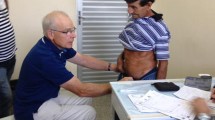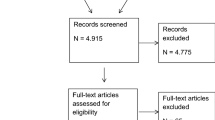Abstract
Inguinal hernia is a common pathology in Western, and even more in African countries.
The dependence on work and the cost of treatment often force the patients to undergo surgical treatment only when there is no other alternative, in emergency, with high risk of morbidity and mortality.
The high prevalence of abdominal wall defects in developed countries has led to the development of different channels of collaboration with the rest of the world and the creation of specific centres also in rural areas for the treatment of abdominal wall hernias.
To reduce as much as possible the gap between the different nations of the world in the surgical treatment and in the perioperative management of abdominal wall hernias, various world organizations have supported humanitarian missions and capacity-building educational collaborations essential to address the global burden of surgical abdominal disease.
Access provided by Autonomous University of Puebla. Download chapter PDF
Similar content being viewed by others
Keywords
1 Background
Inguinal hernia is a common pathology in Western countries (5%), although it is slightly more common in African countries (7.7%). This prevalence is mainly due to the need to carry out extreme physical work, on which their survival depends [1].
Also, the tissues of the abdominal wall present high variability of thickness and resistance among individuals of different races and ethnic groups, probably also due to nutritional deficiencies during the embryogenetic phase and for genetic factors.
The natural history of the hernias of the abdominal wall is to progressively increase in size until it reaches, in some case, conditions such as to affect the performance of normal daily activity; over the years, even working becomes difficult, determining important socio-economic consequences especially in developing countries where it is often neither covered nor protected the worker’s illness.
The extreme dependence on work, the absence of alternative subsistence and the cost for the cure mean that everything that does not require urgent treatment is postponed until there is a condition for which an emergency treatment is indispensable and it is not possible to defer later.
Strangulated hernia is the most common cause of intestinal obstruction and it often results in death or permanent disability [2].
There is an estimated mortality rate of nearly 87% for those who do not reach hospital; for those reaching hospital, the majority have had strangulation lasting longer than 72 h and the overall mortality rate is 40% [3].
A recent review shows that on 100 uncomplicated adult groin hernias reported a 21% complication rate, including: bladder injury, urinary retention, intestinal occlusion, neuralgia, haematoma or immediate recidivation [4].
With the exception of urgent cases, most patients undergo repair surgery when the size of the hernia is so large, abnormal, that we call it hernia permagna.
While the working conditions make the development of hernias of the abdominal wall very frequent in the male, in the female the high rate of multiple caesarean sections makes the laparocele an extremely widespread disease.
While caesarean section is not clinically justified, there is no scientific evidence of the benefits for women or children. However in the developed countries, the non-eutocic delivery is encouraged by the same health structures, they believe that it is more logistically manageable, requires less time and is burdened by fewer maternal post-partum complications.
The high prevalence of abdominal wall defects, associated with socio-economic difficulties, has led to the development of different channels of collaboration with the rest of the world and the creation of specific centres also in rural areas for the treatment of abdominal wall hernias [2, 5].


To reduce as much as possible the gap between the different countries of the world in the surgical treatment and in the perioperative management of abdominal hernias, various world organizations have supported humanitarian missions and educational programs.
A possible educational program for local surgeons could be divided into three steps, at the base there is the historical surgical adage “see one, do one, teach one”.
2 Competency-Based Training Programme
The surgeon trainer first explains the surgical indications and the various therapeutic strategies. The trainer performs the initial operation assisted by the local surgeon in training. During this first phase, the teacher tries to emphasize the key times of the intervention, in the case of inguinal hernia the identification of the three nerves of the region and the anatomical structures, the positioning of the mesh (if available), the management of less simple cases such as inguinoscrotal hernias and, of course, intra- and post-operating complications.
In all subsequent cases, the trainee performed the operations assisted by the trainer. At the end of each operation, the trainer evaluated the trainee’s performance emphasizing the critical issues and giving food for thought about the intervention carried out.


Different items can be evaluated including the surgical gesture, the choice of the incision, the dissection of the tissues, the respect for the anatomy, the fixation of the prosthesis, the dexterity, the choice of instruments, the time and the number of manoeuvres and the performance as a whole.
3 Independent Training Model
At the end of the mission, local instructor surgeons are appointed. These surgeons will select other local surgeons to teach and pass on what they have previously learned from surgeons on a humanitarian mission for second-rate training.


4 Maintenance of Proficiency
The surgeons in training are encouraged to send videos of their surgeries performed after the mission to the surgeons who trained them.
A study conducted with this educational program on the repair of inguinal hernia according to the Liechtenstein repair technique in 16 hospitals, Brazil, Ecuador, Haiti, Paraguay and the Dominican Republic [6] showed how all the surgeons who underwent this training program increased the score given to their performance over time with a rate of complications associated with intervention comparable to what happens in developed countries (USA and Europe) [7,8,9].


A program like this supports collaboration between international institutions and increases the capacity and level of surgical care directly in developing countries.
By forming regional experts, ethical infringements are avoided and the community becomes independent in providing adequate surgical care [10, 11].
Moreover, once the surgeons have become experts and familiar with the type of intervention, they will form, in turn, new local surgeons.
This will increase exponentially the number of local surgeons and the competence of the same in carrying out an abdominal wall surgery ensuring the patient a repair with standards equivalent to those of Western countries.
Each country has its own particular historical–cultural and political context that drastically influences the possibility for local doctors and for the general population to acknowledge the value of a specialized teaching that requires dedicated and regulated economic and structural means.
Prosthesis remains for many countries an unjustifiable or in any case with unaffordable cost.
In the case of abdominal hernia surgery, many areas of the world still tend to adopt open reparative techniques through direct sutures, and videolaparoscopy remains an unaffordable technology from the point of view of costs for over 95% of the population, a utopia reserved only for a few (and extremely rare) privileged centres, almost always located in large capitals.
Often, the absence of a University aggravates the lack of resident doctors and specialists who are able to update themselves on the international scientific reality and to cover the health needs of the territory.
The true relationship between costs and effectiveness of educational programs can only be assessed after some time by calculating how much the project has influenced the health finances of the countries involved in the study.
It remains that today it is very difficult to establish a true follow-up both for patients and for surgical training [12, 13].
An unresolved problem remains: reducing the cost of treatment to allow as many patient as possible the primary care and surgical treatment, hoping that the tendency to arrive at surgical observation only in an emergency should progressively go away in the face of an increase in patients who go to the hospital centres when there is still the possibility of benefit from the advantages of planning surgery.
References
Gil J, Rodríguez JM, Hernández Q, et al. Do hernia operations in African international cooperation programmes provide good quality? World J Surg. 2012;36(12):2795–801. https://doi.org/10.1007/s00268-012-1768-9.
Kingsnorth AN, Oppong C, Akoh J, Stephenson B, Simmermacher R. Operation hernia to Ghana. Hernia. 2006;10(5):376–9. https://doi.org/10.1007/s10029-006-0118-y.
Harouna Y, Yaya H, Abdou I, Bazira L. Prognosis of strangulated inguinal hernia in the adult: influence of intestinal necrosis. Apropos of 34 cases. Bull Soc Pathol Exot. 2000;93(5):317–20.
Fall B, Betel ME, Diarra O, Ba M, Dia A, Diop A. Complications of treatment of adult’s groin hernia: a report of 100 cases comparative study between Bassini and Mac Vay’s technics. Dakar Med. 2005;50(1):37–40.
Turaga KK, Garg N, Coeling M, et al. Inguinal hernia repair in a developing country. Hernia. 2006;10(4):294–8. https://doi.org/10.1007/s10029-006-0111-5.
Wagner JP, Schroeder AD, Espinoza JC, et al. Global outreach using a systematic, competency-based training paradigm for inguinal hernioplasty. JAMA Surg. 2017;152(1):66–73. https://doi.org/10.1001/jamasurg.2016.3323.
Amid PK. Lichtenstein tension-free hernioplasty: its inception, evolution, and principles. Hernia. 2004;8(1):1–7. https://doi.org/10.1007/s10029-003-0160-y.
Amid PK. Groin hernia repair: open techniques. World J Surg. 2005;29(8):1046–51. https://doi.org/10.1007/s00268-005-7967-x.
Vatansev C, Belviranli M, Aksoy F, Tuncer S, Sahin M, Karahan O. The effects of different hernia repair methods on postoperative pain medication and CRP levels. Surg Laparosc Endosc Percutan Tech. 2002;12(4):243–6.
Howe KL, Malomo AO, Bernstein MA. Ethical challenges in international surgical education, for visitors and hosts. World Neurosurg. 2013;80(6):751–8. https://doi.org/10.1016/j.wneu.2013.02.087.
Ramsey KM, Weijer C. Ethics of surgical training in developing countries. World J Surg. 2007;31(11):2061–7. https://doi.org/10.1007/s00268-007-9243-8.
Schroeder AD, Campanelli G, Cavalli M, et al. Humanitarianism in surgery. Hernia. 2017;21(6):963–71. https://doi.org/10.1007/s10029-017-1665-0.
Moore AM, Datta N, Wagner JP, et al. Centralized, capacity-building training of Lichtenstein hernioplasty in Brazil. Am J Surg. 2017;213(2):277–81. https://doi.org/10.1016/j.amjsurg.2016.10.011.
Author information
Authors and Affiliations
Corresponding author
Editor information
Editors and Affiliations
Rights and permissions
Copyright information
© 2019 Springer Nature Switzerland AG
About this chapter
Cite this chapter
Campanelli, G., Bruni, P.G., Cavalli, M., Lombardo, F.M. (2019). Evolution of Abdominal Wall Surgery in Non-developed Countries. In: Greco, D.P., Borgonovi, E. (eds) Abdominal Wall Surgery. Springer, Cham. https://doi.org/10.1007/978-3-030-02426-0_19
Download citation
DOI: https://doi.org/10.1007/978-3-030-02426-0_19
Publisher Name: Springer, Cham
Print ISBN: 978-3-030-02425-3
Online ISBN: 978-3-030-02426-0
eBook Packages: MedicineMedicine (R0)




